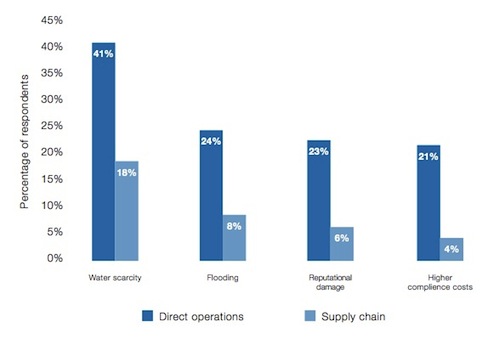Big California companies and investors see “significant near-term risk” at the spigot

Companies around the world are beginning to recognize “a significant near-term risk” to their water supplies, according to the second annual Water Disclosure Global Report released today by the non-profit Carbon Disclosure Project (CDP) in London. But despite the obvious connection, water appears to lag climate as a priority in corporate boardrooms. The CDP report found that a whopping 94% of Global 500 companies that responded have board-level oversight of climate change. Water risks, not so much: just 57% of the respondents to the water disclosure report have board level oversight on those issues.
Who might be interested in such info? Three hundred fifty-four institutional investors who signed on to request it, including the California Public Employees Retirement System (CalPERS), the California State Teachers Retirement Systems (CalSTRS) and the California State Treasurer, Bill Lockyer. The group — retirement funds from Scotland to South Africa among them — represents $43 trillion in assets. The California entities, along with the other 351, want to know how corporations in which they invest are handling water risks like severe weather and shortages, as well as opportunities like efficiency and recycling.
The 2030 Water Resources Group, a collection of government and business concerns, estimates that “demand for water will outstrip supply by 40% by 2030 and that closing this gap could cost as much as $50 to $60 billion a year [in global capital investment] for twenty years.”
The data in today’s report comes from a questionnaire sent out to 315 companies on the Global 500 index that are “operating in the most water-stressed locations or industry sectors.” Among them were a number of California’s largest companies: Intel, Cisco Systems, Amgen, Hewlett-Packard, Occidental Petroleum, PG&E and Yahoo. Those that declined to participate included Chevron, Apple, Northrup Grumman, Google and eBay.

The two risks at the top of the list of company concerns — water scarcity and flooding — are also mentioned by the report’s authors as two consequences of climate change. More than a third of the respondents say they’ve already suffered water-related issues and events, with losses as high as $200 million. But two-thirds of the North American respondents saw opportunity in the water issue. Of the companies that consented to be named, Cisco Systems shared how it solved a water risk with several of its suppliers:
“Cisco Systems worked with three of its printed circuit board assembly partners to implement a new soldering practice that rendered the water-intensive wash stage of the manufacturing process unnecessary. By 2010, this new practice had been implemented company-wide, saving Cisco Systems over US$1 million each year with no adverse impact on product quality.”
There was also a recognition of the complexity of the water use-versus-carbon emissions trade-off that businesses must now wrestle with. Nestle, for example, decided not to embrace biofuels made from maize and wheat because of the high cost of watering such crops.
A low level of corporate board attention is especially dramatic among the energy companies that responded: only one-third of them reported board-level oversight of water strategies yet almost three-quarters of them reported exposure to higher levels of water-related risk than the rest of the respondents as a group.
The Carbon Disclosure Project predicts that “the companies that succeed will be those that consider water with the strategic importance it deserves and take steps to transform their business now.”
2 thoughts on “Water Risks a Looming Iceberg for Global, California Business”
Comments are closed.

A coupled of questions to ponder.
1) If water is so critical, why are we not building more dams in California to store the Sierra runoff?
2) Where is all the water going as the sea level drop is accelerating, from 2007 to 2010 it was dropping about 1.7mm per year and now it is dropping about 2.7 mm per year. Can we assume that the oceans are evaporation the the water is being stored as snow and ice some where, that will eventually become water?
Russell: If the water stop flowing from the mountains due to the ice disappearing, more dams will be short-lived solution and a waste of money. There’ll be no water to fill them. The sea level is rising and will continue to rise, not fall. Estimates range from 0.6 to 1.8 metres rise by 2100. South Pacific Islands are disappearing as well as coastal beaches. You can go to NASA or NOAA for this information.